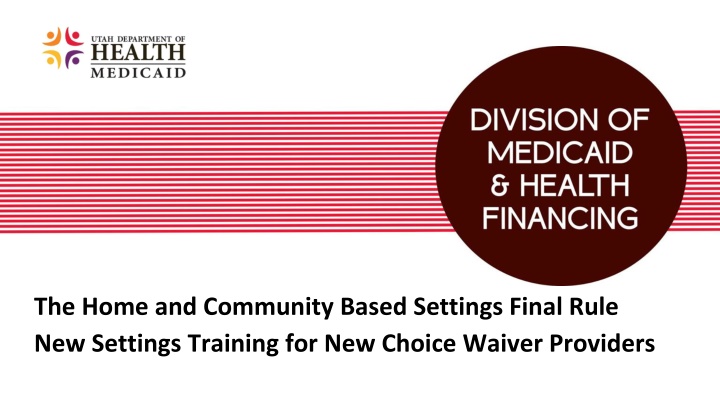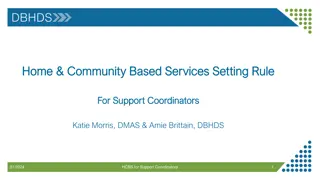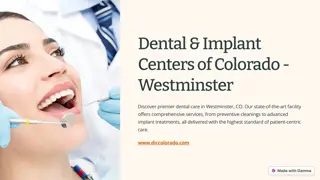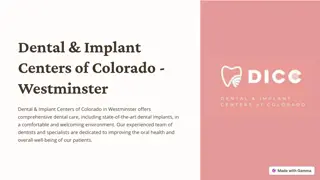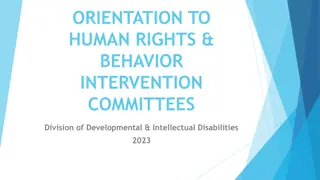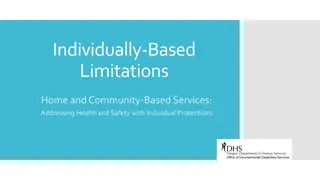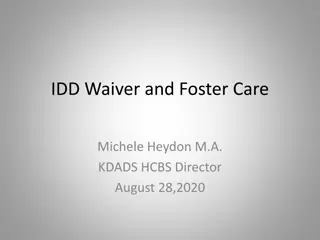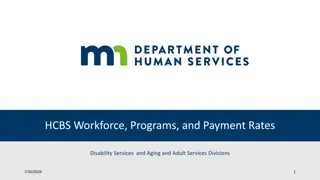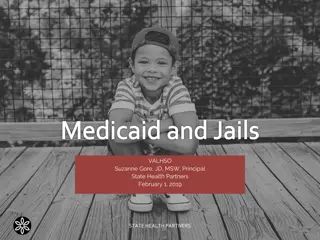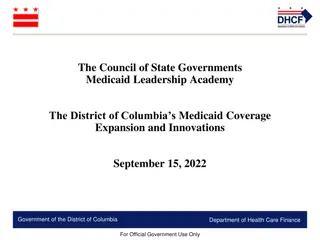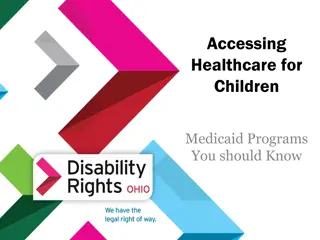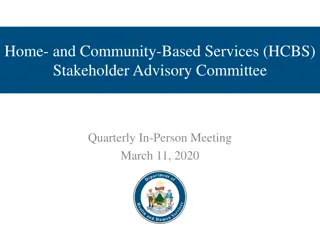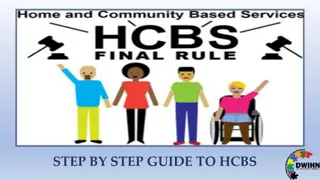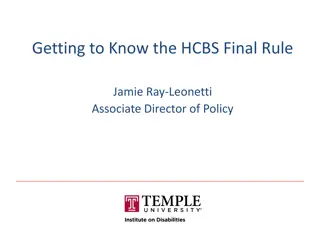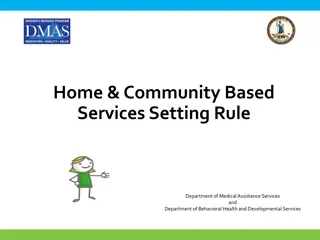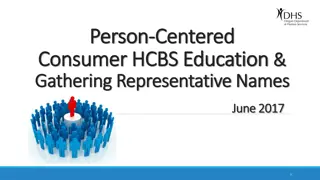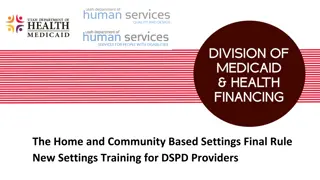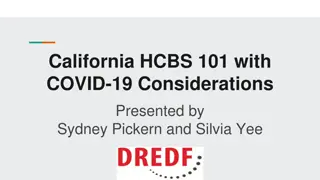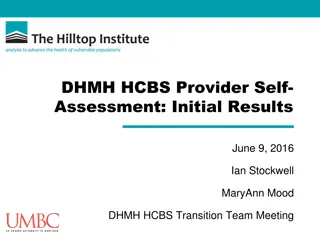The HCBS Setting Requirements in Medicaid
The Home and Community Based Settings Final Rule, effective since March 17, 2014, outlines requirements for where and how services are provided to individuals under a Medicaid home and community-based waiver. Compliance with the rule is essential for both existing and new settings to ensure proper community inclusion for Medicaid HCBS participants.
Download Presentation

Please find below an Image/Link to download the presentation.
The content on the website is provided AS IS for your information and personal use only. It may not be sold, licensed, or shared on other websites without obtaining consent from the author.If you encounter any issues during the download, it is possible that the publisher has removed the file from their server.
You are allowed to download the files provided on this website for personal or commercial use, subject to the condition that they are used lawfully. All files are the property of their respective owners.
The content on the website is provided AS IS for your information and personal use only. It may not be sold, licensed, or shared on other websites without obtaining consent from the author.
E N D
Presentation Transcript
The Home and Community Based Settings Final Rule New Settings Training for New Choice Waiver Providers
The Final Rule: HCBS Setting Requirements The Home and Community Based Settings Final Rule (or Settings Rule) is a federal rule that governs where and how services are provided to individuals receiving services under a Medicaid home and community based waiver. All services that fall under a Medicaid Home and Community Based Waiver have to or will have to comply with this rule. For NCW services, Adult Day Care and Residential services area focus of this presentation. All other services are considered presumed compliant under the settings rule.
The Final Rule: HCBS Setting Requirements Effective date of rule: March 17, 2014 States must demonstrate compliance with the rule by March 17, 2022 for all existing services. New settings must be in compliance now -- before services are provided in the new setting. The final rule establishes: Mandatory requirements for the qualities of home and community based settings Settings that are not home and community based Settings presumed not to be home and community based State compliance and transition requirements
The Final Rule: HCBS Setting Requirements New Settings Requirements Any setting in which services were not being provided under an HCBS Waiver as of March 17, 2014 must be in compliance with the regulations for HCBS settings by the effective date of the program (the start of services). Federal Financial Participation (FFP)/funding will not be available for Medicaid-funded HCBS provided in presumptively institutional settings that are unable or unwilling to demonstrate compliance with the settings regulatory criteria. (Medicaid cannot pay for services that don t comply.) FFP/funding for Medicaid funded HCBS will be available for expenditures associated with the dates of service beginning on the date the State confirmed all remediation was completed and the setting demonstrations compliance with the regulation. (Medicaid may begin paying for services that do comply starting on the date that the State confirms the provider has addressed all issues related to compliance.)
The Final Rule: HCBS Setting Principle Goal The underlying principle of the HCBS Settings Rule and the goal of system transformation is COMMUNITY INCLUSION for all Medicaid HCBS participants
Settings that are NOT HCBS or Presumed NOT HCBS Some settings are NOT Home and Community Based Services by nature of the setting. These include: Nursing Facilities Institution for Mental Diseases (IMD) Intermediate Care Facility for Individuals with Intellectual Disabilities (ICF/IDD) Hospital
Settings that are NOT HCBS or Presumed NOT HCBS Some settings are Presumed NOT to be HCBS. These include: Settings in a publicly or privately-owned facility providing inpatient treatment Settings on grounds of, or adjacent to, a public institution Settings with the effect of isolating individuals from the broader community of individuals not receiving HCBS
Settings that are NOT HCBS or Presumed NOT HCBS CMS intends to take the following factors into account in determining whether a setting may have the effect of isolating individuals receiving Medicaid HCBS from the broader community: Due to the design or model of service provision in the setting, individuals have limited, if any, opportunities for interaction in and with the broader community; The setting restricts beneficiary choice to receive services or to engage in activities outside of the setting; or The setting is physically located separate and apart from the broader community and does not facilitate beneficiary opportunity to access the broader community and participate in community services, consistent with a beneficiary s person-centered service plan.
Settings that are NOT HCBS or Presumed NOT HCBS Rural settings: Settings located in rural areas are not automatically presumed to have qualities of an institution, and more specifically, are not considered by CMS as automatically isolating to HCBS beneficiaries. With respect to determining whether a rural setting may be isolating to HCBS beneficiaries, compare the access that individuals living in the same geographical area (but who are not receiving Medicaid HCBS) have to engage in the community.
HCBS Setting Requirements The Settings Rule defines that a Home and community based Setting: Is integrated in and supports access to the greater community Provides opportunities to seek employment and work in competitive integrated settings, engage in community life, and control personal resources Ensures the individual receives services in the community to the same degree of access as individuals not receiving Medicaid home and community based services (HCBS) Note: Reverse integration activities are not sufficient to meet the true intent and spirit of the HCBS settings rule. (Reverse integration involves bringing people and activities from the broader community into the setting, instead of supporting people in the setting to access the broader community.) Visits by community members have value, but cannot replace community access for individuals.
HCBS Setting Requirements What can this look like? The setting is located among other residential buildings, private businesses, retail businesses, restaurants, etc. that facilitates integration with the greater community. The setting allows the individual(s) the freedom to move about inside and outside of the setting as opposed to one restricted room or area within the setting and they are allowed to come and go at any time. The setting facilitates the opportunity for the individual(s) to have access to and control personal funds. The setting provides information about, or training on, how to access and use public transportation, such as buses, taxis, uber, etc.
HCBS Setting Requirements The Settings Rule defines that a Home and community based Setting: Ensures an individual s rights of privacy, dignity, respect, and freedom from coercion and restraint Optimizes individual initiative, autonomy, and independence in making life choices Facilitates individual choice regarding services and supports, and who provides them
HCBS Setting Requirements What does this look like? Ensures an individual s . Information is kept private. The setting staff interact and communicate with the individual(s) respectfully and in a manner in which they would like to be addressed. Individual(s) can have a private cell phone, computer, or other personal communication device, or the setting provide access to a device to use for personal communication in private. In settings with more than one individual, each individual s supports and plans to address behavioral needs are specific to the individual and not the same as everyone else in the setting.
HCBS Setting Requirements What does this look like (continued)? Optimizes individual initiative The setting offers a secure place for the individual(s) to store personal belongings. The setting supports individuals who need assistance with their personal appearance in private. The setting affords dignity to the diners (i.e. not required to wear bibs) The setting allows the individual(s) to engage in legal activities (ex. voting when 18 or older, consuming alcohol when 21 or older) in a manner consistent with individuals not receiving Medicaid funded services and supports. The physical environment supports a variety of individual goals and needs (indoor and outdoor gathering spaces, larger group activities as well as solitary activities; stimulating as well as calming activities).
HCBS Setting Requirements What does this look like (continued)? Facilitates individual choice The setting does not restrict services, providers, or supports and affords the opportunity for individual(s) to update or change their preferences. The setting provides the individual(s) receiving support in developing plans / individualized goals to support their needs and preferences. Setting staff is knowledgeable about the capabilities, interests, preference and needs of the individual. Tasks and activities are matched to individual skills, abilities and desires. Individual(s) sit in any seat in the dining area, can eat privately if desired, and can request an alternative meal.
HCBS Requirements for Provider-owned or Controlled Residential Settings There are requirements that are specific to Provider Controlled Residential Settings Only. These include the following: The individual has a lease or other legally enforceable agreement providing similar protections. The setting ensures the individual has privacy in their sleeping or living unit including lockable doors, choice of roommates, and freedom to furnish or decorate the unit. The setting ensures the individual has the freedom and support to control his/her own schedule and activities, and have access to food at any time. The individual can have visitors of his/her choosing at any time. The setting is physically accessible to the individual
HCBS Requirements for Provider-owned or Controlled Residential Settings Legally enforceable agreement: A lease or residency agreement is provided to each resident and the lease or agreement should be comparable to those provided under the jurisdiction landlord tenant laws Individuals are informed of their rights regarding housing and when they could be required to relocate Individuals are informed of how to relocate and request new housing The written agreement includes language that provides protections to address eviction processes and appeals comparable to those provided under the jurisdiction landlord tenant laws
HCBS Requirements for Provider-owned or Controlled Residential Settings Individual has privacy and freedom to furnish or decorate their unit: Only necessary staff have keys or access to keys to an individuals private living space (house, apartment, room, etc.) Staff only use a key to enter a living area or privacy space under limited circumstances agreed upon with the individuals Staff always knock and receive permission prior to entering a private living space Furniture, linens, and other household items reflect individual preferences, interests, and hobbies as desired Individuals have a choice of roommates Individuals know how to request a roommate change
HCBS Requirements for Provider-owned or Controlled Residential Settings Locks A workgroup comprised of various stakeholders met and discussed locks in a residential setting where an individual s room is their private living space in depth on April 17, 2018. The workgroup came to the consensus that having a lock on both the bedroom and bathroom door is the default to ensure individual dignity and respect. It is the choice of the individuals when or how they use the lock. Individuals must be able to close and lock their bedroom and bathroom door unless there is a restriction to the individual for health and safety reasons and implemented on a case-by-case basis for an assessed need that has been approved through the appropriate processes and are documented in the person centered plan.
HCBS Requirements for Provider-owned or Controlled Residential Settings Locks (continued) When installing locking door hardware, locks also need to comply with R432-6, ADA, and the International Fire Code. To be in compliance, locks need to be: Equipped with hardware which permits emergency access from the outside Of the lever type Operable with one hand Unlatching by one operation Fully operable without tight grasping, pinching, or twisting of the wrist Operable with a maximum force of 5 pounds Provided with a maneuvering clear space on both sides complying with ADA 404.4.2.
HCBS Requirements for Provider-owned or Controlled Residential Settings Cameras in the New Choices Waiver Residential Settings: Surveillance cameras in a setting may change the perception of the site as institutional in nature versus Home and Community Based. Although the allowance/prohibition of cameras is not specifically discussed in the HCBS Settings Final Rule, a minimum requirement of States is to ensure individual rights to privacy, dignity, and respect in all HCBS service settings. Removal of cameras is not a requirement of the Settings Rule. The use of cameras must be assessed against the HCBS Settings Rule to ensure that the presence and intended use of cameras is in compliance with the Rule.
HCBS Requirements for Provider-owned or Controlled Residential Settings Cameras in the New Choices Waiver Residential Settings (continued): Surveillance equipment in the following circumstances generally do not raise privacy concerns and can be used as similar non-HCBS settings would use them: In areas dedicated to provider staff (desks/offices) Monitoring entrances and exits Monitoring exterior areas of the building (parking lots) In commercial/integrated areas of the setting (such as stores, cafes, etc.)
HCBS Requirements for Provider-owned or Controlled Residential Settings Cameras in the New Choices Waiver Residential Settings (continued): Surveillance equipment may also be used if it achieves one of the following: Increased independence for individual(s) receiving HCBS services Addresses a complex medical condition or other extreme circumstance Reduces or minimizes critical incidents Improves the quality of supports
HCBS Requirements for Provider-owned or Controlled Residential Settings The individual can have visitors of his/her choosing at any time. There are no set visiting hours There are no restricted visitor meeting areas Individual(s) can have private visits with family and friends
HCBS Requirements for Provider-owned or Controlled Residential Settings The setting is physically accessible to the individual The setting ensures there are no gates, Velcro strips, locked doors, or other barriers preventing individual s entrance to or exit from certain areas of the setting. The setting provides the individual(s) with full access to typical facilities in a home such as a kitchen with cooking facilities, dining area, laundry, and comfortable seating in the shared areas. The setting is physically accessible (the setting must meet all ADA requirements) or if there are obstructions, environmental adaptations such as a stair lift or elevator to ameliorate the obstruction are in place. Note: Compliance with ADA does not equal compliance with all settings rule accessibility requirements as noted above.
HCBS Setting Requirements: Modifications and Restrictions There are situations that an exception or modification to any of the settings requirements or a restriction to the participant s rights can be imposed. In these circumstances the modifications or restrictions must be: Supported by an individualized specific assessed need Justified in the person-centered support plan Documented in the person-centered support plan
HCBS Setting Requirements: Modifications and Restrictions Supported by a specific assessed need: Restricting independence or access to resources is appropriate only to reduce specific risks. Controls on personal freedoms and access to community cannot be imposed on a class or group of individuals. Restrictions or modifications cannot be implemented as house rules in any setting, regardless of the population served and must not be used for the convenience of staff.
HCBS Setting Requirements: Modifications and Restrictions Supported by a specific assessed need (continued): For those restrictions that affect other individuals in the setting, there must be a way for them to circumvent the restriction. For example, if an individual requires a food restriction that results in the refrigerator being locked, there must be a way for other individuals to access that food (e.g. access to key, code, etc.) Documentation of a diagnosis is not sufficient justification. This section must clearly demonstrate an assessed need for the modification including critical events or situations that have transpired that support the need for the modification.
HCBS Setting Requirements: Modifications and Restrictions Documented in the person-centered support plan which includes: Specific individualized assessed need Prior interventions and supports including less intrusive methods Description of condition proportionate to assessed need Ongoing data measuring effectiveness of modification Established time limits for periodic review of modifications Individual s informed consent Assurance that interventions and supports will not cause harm
HCBS Setting Requirements: Modifications and Restrictions Unsafe Wandering or Exit-Seeking Behavior: Settings with controlled-egress should be able to demonstrate how they can make individual determinations of unsafe exit-seeking risk and make individual accommodations for those who are not at risk. Should a person choose a setting with controlled-egress, the setting must develop person-centered care plans that honor autonomy as well as minimize safety risks for each person, consistent with his or her plan goals. Technological solutions, such as unobtrusive electronic pendants that alert staff when an individual is exiting, may be used for those at risk, but may not be necessary for others who have not shown a risk of unsafe exit-seeking behavior. For example, spouses or partners who are not at risk for exit-seeking and who reside in the same setting should have the ability to come and go by having the code to an electronically controlled exit.
HCBS Settings Transformation Change of Mindset Systemic change requires a change in CULTURE NOT just a compliance mindset. When approaching the implementation of the Settings Rule, integrate change in the policies, processes, power structures, values, and norms of programming, resulting in ongoing system transformation. The following slides include principles that support this change in mindset and examples of how some providers are implementing them.
Modernizing HCBS Settings Examples of Promising Provider Service Principles: The best place to learn how to live and work in the community is in the community. What can this look like? Hanging out with friends in the community instead of at a provider controlled facility Assisting individuals to develop meaningful relationships with others in the community (creating natural supports) Allow individuals to maintain or increase their independence in the community; such as making the transaction when purchasing something If an individual is interested in working, they are given the opportunity to explore and experience work and/or volunteer activities
Modernizing HCBS Settings Examples of Promising Provider Service Principles: Our buildings should be places for people to come and go not to stay. What can this look like? Individual interests should be matched with other individuals receiving services to form like groups A formal process for individuals to create their schedule should be in place Providing transportation training and coordinating transportation so individuals that can, can independently experience life in the community vs in the facility Assist individuals to develop relationships in the community to create a sense of safety and make it more likely for individuals to frequent that space (e.g. the staff at a local coffee shop know their name)
Modernizing HCBS Settings Examples of Promising Provider Service Principles: We shouldn t provide things here that exist naturally in the community. What can this look like? Attend classes in the community instead of at a provider controlled setting (e.g. exercise, cooking, arts & crafts, etc.) Participate in community events instead of a provider controlled event (e.g. plays, dances, craft fairs, art exhibits, etc.) Use natural supports to assist individuals in accessing their community (e.g. providing transportation, assistance navigating community, budgeting ,etc.)
Modernizing HCBS Settings We must balance preservations of assuring safety with the dignity of risk there is room for both Dignity of risk means allowing individuals the right to take reasonable risks as it is essential for their dignity and self esteem and should not be stopped by overly cautious team members. Positive risk-taking: Improved autonomy Improves social interaction Improves health Live independently Construct their lives in accordance to their values and personality Self-determination and feelings of worth Over-protection: Patronized Smothers the person Removes hope Diminishes the person Prevent individuals reaching potential For more information visit: https://www2.health.vic.gov.au/~/media/Health/Files/Collections/Presentations/S/Striving-For-Care- Excellence/Exploring-the-concept-of-Dignity-of-Risk
Modernizing HCBS Settings We must balance preservations of safety with the dignity of risk there is room for both continued Informed decision making is a process where you support an individual to obtain information and knowledge about a situation or problem and make a decision. 1. Assist the individual to understand the decision/issue/situation 2. Gather information 3. Explore options and consider outcomes 4. Allow the individual to decide, act, and empower 5. Evaluate the decision For more information visit: https://i2icenter.org/wp-content/uploads/2019/06/Informed-Decision-Making-Presentation.pdf
Modernizing HCBS Settings We must balance preservations of assuring safety with the dignity of risk there is room for both (continued) Example: An individual wants to go to Lagoon. You know that they get carsick and have a hard time walking for long periods. You support the individual in making an informed decision. You support their decision because it will benefit them and improve their autonomy and self-worth.
Modernizing HCBS Settings We must balance assuring safety with the dignity of risk there is room for both (continued) It is a providers responsibility to assure safety, and individuals have the right to make decisions in their life. We all make decisions that are not always the healthiest or safest. When these conflict, the team must consider the severity and the likelihood of potential negative outcomes against the rights of the individual and limit those rights only when truly necessary, and according to the requirements of the Settings Rule. The team should consider every possible way for the person to carry out the decision they are making to the greatest extent possible.
Modernizing HCBS Settings Provider to Provider Tips on Making the Shift to Community Integration: Do it one person at a time, and do it a lot of times until you re done. You ll get better at what you do. Don t get stuck in planning and waiting for the right time to change . Hire for who you want to become, not for who you are. Set goals and create clear strategies to achieve your desired outcome. Monitor your progress.
Modernizing HCBS Settings Promising Practices for Providers- Community Integration: Developing partnerships and building relationships with businesses or organizations in the community that people of all abilities can be a part of Participate in an advisory group that consists of members of the community, family members, and individuals to increase individualized community based service offerings
Modernizing HCBS Settings Promising Practices for Providers- Natural Supports: Utilizing a variety of public transportation options (including ride shares, taxi services, virtual transportation services, etc.) to promote optimal individualization of scheduling and activities Fostering access to technology and other innovations as a way to stimulate natural supports Offering activities and programs that encourage families and friends to participate regularly and that promote greater independence and autonomy
Modernizing HCBS Settings Simply THINK BIG START SMALL SCALE FAST
Modernizing HCBS Settings Former Practice New Practice Provide services at the setting (e.g. church, salon) Bring in visiting artists/classes Group planning Provider creates the program schedule Over-protection Limited choice Attend and identify services in the community Identify community classes One person at a time Individuals create their schedule Positive risk-taking Informed decision making
References Woolford M., Lacy-Vawdon C., Ibrahim J., Bugeja L., and Weller C. Exploring the concept of Dignity of Risk. Monash Forensic Medicine, Monash University. Raffaele J. (2019). Informed Decision Making, Direct Support Professional Roles & Responsibilities. National Alliance for Direct Support Professionals, Center for Integrative Health.
Resources HCBS Settings Rule Transition Home Page: http://medicaid.utah.gov/ltc/hcbstransition/ Sign up for the HCBS Settings ListServ here: https://medicaid.utah.gov/medicaid-long-term-care-and-waiver- programs HCBS Settings Email: HCBSSettings@Utah.gov
Quiz As a new setting, a quiz is required. There are 10 questions with a possible 30 points. The passing score is 90% (27/30). You can retake the quiz if you do not pass the first time.
